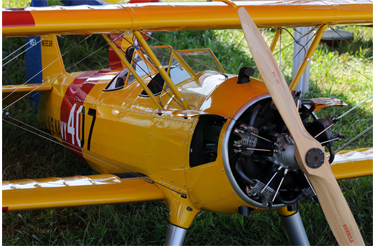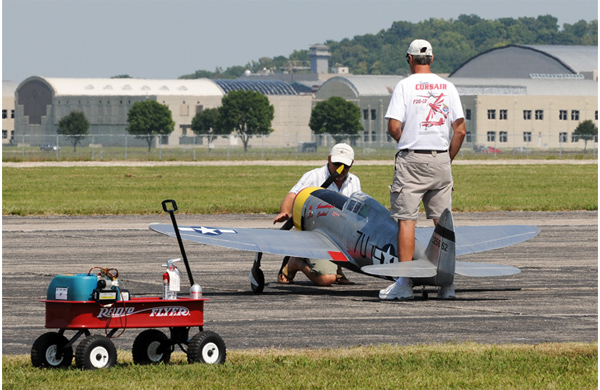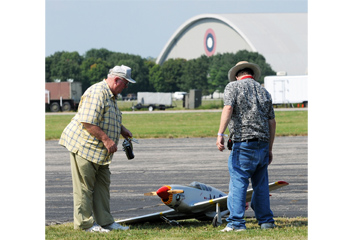
B-17 Giant Scaler Model Airplane
No, the olive-drab aircraft above is not a real B-17--not many of them are still flying. This is a scale model of an actual B-17. It has four model airplane engines, retractable landing gear, and in this image it looks like the real thing. These aircraft are moving pretty fast and some distance away (for safety reasons) but the images are not too blurry; that's because I was panning the camera to keep it focused on the flying model.
We attended the 2009 Dayton Ohio Giant Scaler (DOGS) model airplane airshow. It was held on a deserted runway that is part of The Air Force Museum near Dayton. Even if these models require considerably less runway that actual aircraft, the old runway is perfect for landing and taking off these larger models.
We have seen a lot of model airplanes before, but nothing we have seen compares to this event. The planes were beautiful and their pilots were able to do stunts with them that could never be done with the real thing.
|

The Big Guy is Jim clearing off his camera card to photograph Giant Scale Model Airplanes
|
|
There was a variety of aircraft at the DOGS airshow. They ranged from models of early biplanes (like the one above) to models of Navy and Air Force fighter jets. These planes have large engines as can be seen and they can be made to do spectacular stunts. I can't imagine what it would feel like to crash one of these beauties
|

Open Cockpit Biplane Model Airplane
|
|

Aircraft Maintenance
|
These aircraft require maintenance and tune-ups just like their bigger brothers. When their owners weren't tinkering with them, they appeared to be polishing them.
|
|

Couple Tows Model to Ready Line
This couple's plane had Jamaican influence as the plane was painted the appropriate colors and the pilot inside wore a stylish cap. The little pilot had dreadlocks and wore a colorful knit hat.
|

Starting the Engine
Starting the engine can be hazardous to your fingers and requires a bit of courage. The prop can be flipped by hand ensuring that it is out of the way before the prop can come around when the engine fires and smack your knuckles. An electric starter is also available that spins the cone on the propeller's center. We liked the red Flyer used to tote fuel and other supplies.
One person positions himself in front of the horizontal stabilizer during starting and warm-up to keep the model from taking off. These models can take off across the runway rather than lengthwise but this is considered poor form.
|

Model Flying Control Station
There were six stations marked with numbers and straw bales. Controllers stood behind the bales--a safe place to be when taxiing your plane up to yourself after landing. There were times when six airplanes were in the air at one time. Each operator uses a different radio frequency to control their aircraft.
The Air Force Museum is shown in the background. The large silo contains intercontinental ballistic missiles and is programmed to house a Minuteman and Peacekeeper ICBM that Jim worked on.
|

Touching the Ground With Your Tail
These models have such powerful engines that they can literally hang from their propeller. By precise attitude adjustments and throttle control, the aircraft can be lowered slowly until its tail touches the grass. Ideally, the aircraft is oriented to show off your colors (and advertisements) to the crowd. Once this feat is accomplished, the aircraft climbs straight up like a rocket--impressive.
|

Inverted Fly-By
Some people have it all. This person has an electric truck for riding around the airshow, a nice swiveling bar stool to follow the action, a side stand to hold his drink, and a cooler full of beverages. What more could one ask for at an airshow?
A slow inverted fly-by maintaining the same altitude requires practice since the controls become reversed--pulling the stick back makes the nose go down--opposite of normal flying. As attitude is increased, speed must be reduced to maintain the same altitude, etc. It is a fine balancing act.
|
|
|

Going Back to the Hanger
Following a great performance, the pilot of this beautiful model tows it back to his space. There are some great images of this plane in flight on the next page.
|

B-17 Gets a Tow
|

Rough Landing
Not all landings are good landings. The poor aircraft above seems to have had a landing gear malfunction. These landing gear are retractable to make the airplane more streamlined, but the actuators that lower them don't always work properly. Sometimes, landing too hard can also cause the landing gear to fail. We saw wheels passing up the model as it skidded down the runway.
|





